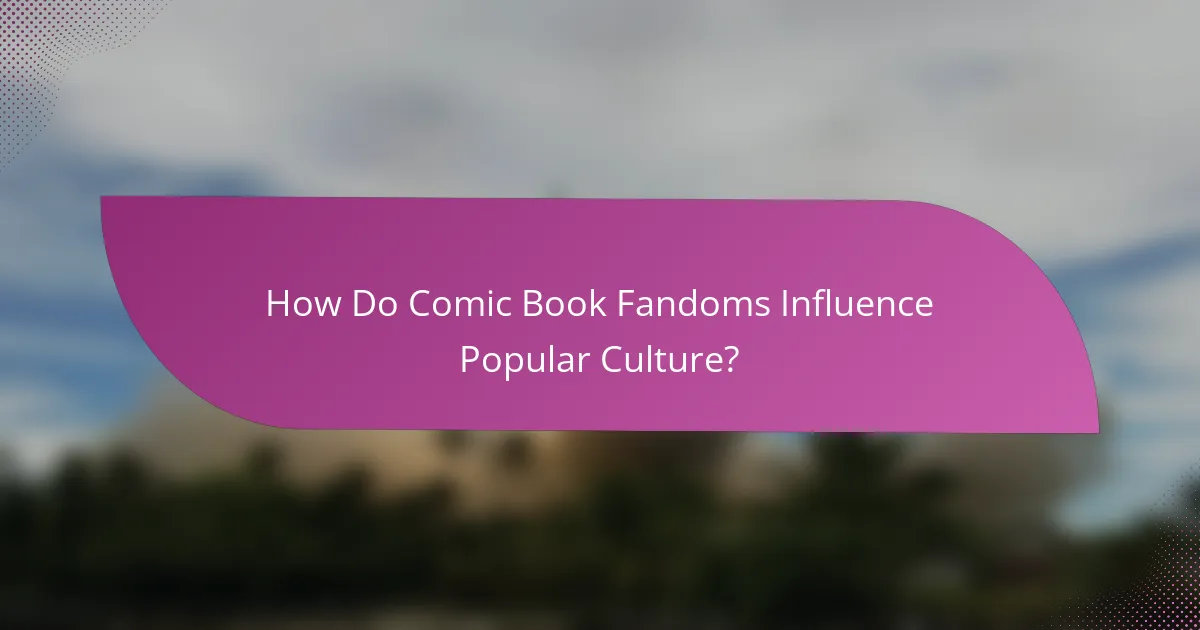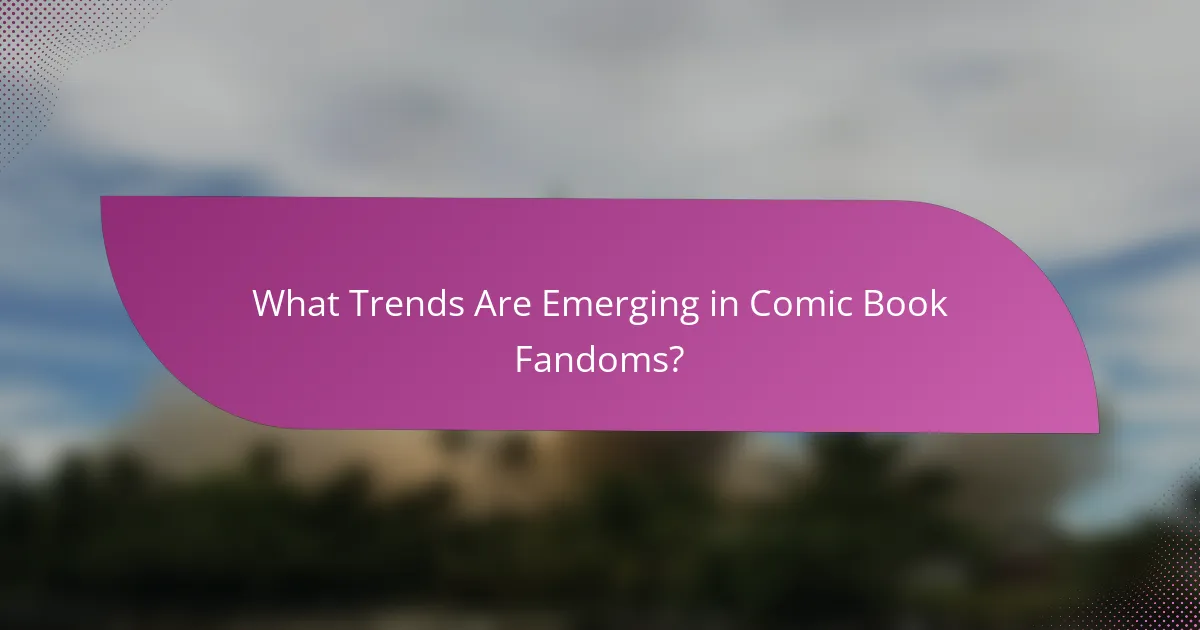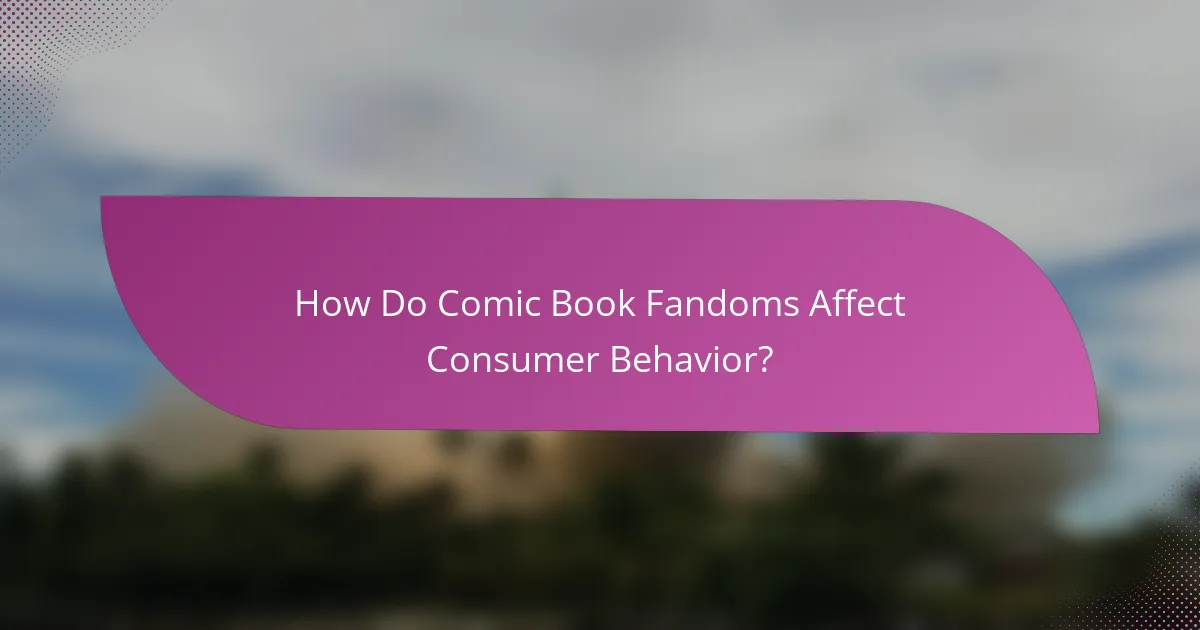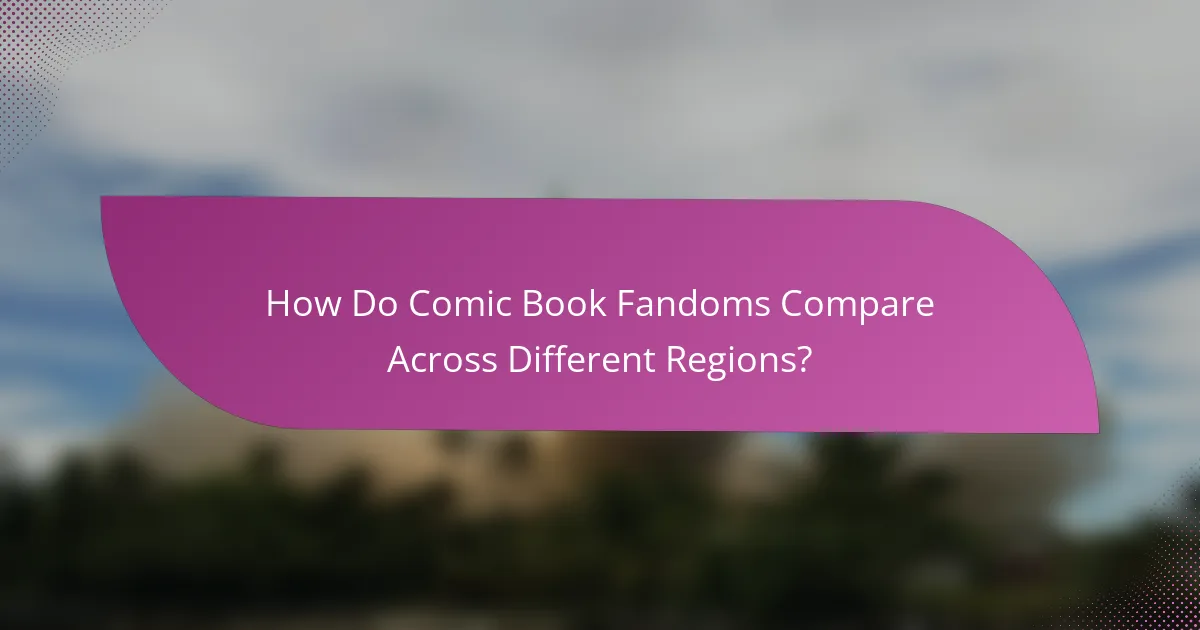Comic book fandoms play a crucial role in shaping popular culture, influencing trends across media, fashion, and social movements. These dedicated communities not only advocate for representation and innovation but also drive consumer behavior, impacting what is produced and consumed in the entertainment landscape.

How Do Comic Book Fandoms Influence Popular Culture?
Comic book fandoms significantly shape popular culture by driving trends in various media, fashion, and social movements. Their passionate communities advocate for representation and innovation, influencing what is produced and consumed across multiple platforms.
Impact on film and television
Comic book fandoms have transformed the film and television landscape, leading to a surge in superhero adaptations. Major studios invest heavily in comic-based franchises, resulting in blockbuster films and successful series that dominate box offices and streaming platforms.
For instance, the Marvel Cinematic Universe has generated billions in revenue, showcasing how fan enthusiasm can dictate production priorities and marketing strategies. This influence encourages studios to prioritize diverse storytelling and character development to cater to evolving audience expectations.
Shaping fashion trends
Comic book fandoms also impact fashion, with superhero-themed apparel becoming mainstream. Merchandise such as graphic tees, accessories, and cosplay outfits are not only popular among fans but have also influenced high fashion, with designers incorporating comic motifs into their collections.
Events like Comic-Con showcase this trend, where attendees often wear elaborate costumes, further blurring the lines between everyday wear and fandom-inspired fashion. Retailers frequently capitalize on this by offering exclusive collections that resonate with both fans and fashion enthusiasts.
Influence on social movements
Comic book fandoms have played a crucial role in advocating for social movements, particularly around issues of representation and diversity. Characters from diverse backgrounds have emerged from fan demands, prompting publishers to create more inclusive narratives that reflect contemporary societal values.
For example, the popularity of characters like Miles Morales and Kamala Khan highlights the growing recognition of multiculturalism in comics. This shift encourages broader discussions about identity, equality, and social justice within and beyond the fandom community.
Integration into mainstream media
As comic book fandoms gain traction, their influence extends into mainstream media, with comic-inspired content appearing in various formats, including podcasts, novels, and video games. This integration allows for a richer exploration of comic narratives and characters, reaching wider audiences.
Platforms like Netflix and Disney+ have capitalized on this trend by producing original content based on comic properties, further solidifying their place in popular culture. As a result, fans have more access to stories that resonate with them, fostering a deeper connection to the source material.

What Trends Are Emerging in Comic Book Fandoms?
Emerging trends in comic book fandoms reflect significant shifts in how fans engage with content and each other. Key developments include the rise of digital comics, the growth of online communities, and increased diversity in storytelling.
Rise of digital comics
The rise of digital comics has transformed how fans access and consume their favorite titles. Platforms like ComiXology and Webtoon offer vast libraries of comics that can be read on various devices, making it easier for fans to discover new series and creators.
Digital comics often feature unique formats and interactive elements that enhance the reading experience. For instance, some platforms allow for vertical scrolling, which caters to mobile users and offers a different narrative pacing.
Growth of online communities
Online communities have flourished around comic book fandoms, providing spaces for fans to connect, discuss, and share their passion. Social media platforms, forums, and dedicated websites facilitate these interactions, allowing fans to engage with creators and each other in real-time.
These communities often organize events such as virtual conventions and fan art competitions, fostering a sense of belonging and collaboration. Fans can easily find groups that align with their interests, whether they focus on specific genres, characters, or creators.
Increased diversity in storytelling
Increased diversity in storytelling is a notable trend in comic book fandoms, with more creators from varied backgrounds contributing to the medium. This shift has led to richer narratives that explore different cultures, identities, and experiences, resonating with a broader audience.
Publishers are actively seeking diverse voices, resulting in a wider range of characters and story arcs. For example, titles featuring [censured] protagonists or stories centered around underrepresented communities are becoming more common, reflecting the changing demographics of readers.

How Do Comic Book Fandoms Affect Consumer Behavior?
Comic book fandoms significantly influence consumer behavior by shaping preferences, driving purchases, and creating community engagement. Fans often align their buying habits with their favorite characters and franchises, leading to increased sales in various merchandise categories.
Merchandising impact
Comic book fandoms create a robust market for merchandise, including action figures, apparel, and collectibles. Fans are willing to spend on items that reflect their passion, often prioritizing limited editions or exclusive releases. For example, a popular comic book character may see merchandise sales increase by 20-30% during major film releases.
Retailers often capitalize on this enthusiasm by offering themed products and promotional events. Collaborations between comic publishers and brands can lead to unique merchandise, further enhancing consumer interest and driving sales.
Event attendance and participation
Comic book conventions and events attract large crowds, with many fans traveling significant distances to attend. These gatherings provide opportunities for fans to engage with creators, participate in panels, and purchase exclusive merchandise. Attendance at major conventions can reach tens of thousands, demonstrating the strong community ties among fans.
Participation in events often leads to increased spending on both merchandise and experiences, such as meet-and-greets or workshops. Fans may budget hundreds to thousands of dollars for travel, accommodations, and event tickets, reflecting their commitment to the fandom.
Influence on purchasing decisions
Comic book fandoms heavily influence purchasing decisions, with fans often relying on recommendations from peers and online communities. Social media platforms and forums play a crucial role in shaping opinions and driving interest in new titles or merchandise. Fans frequently share reviews and unboxing videos, which can significantly impact sales.
Moreover, the rise of subscription services for comics and collectibles has changed how fans engage with their interests. Many fans opt for monthly subscriptions, ensuring they receive the latest issues or exclusive items, which can lead to consistent spending patterns over time.

What Are the Key Characteristics of Comic Book Fandoms?
Comic book fandoms are characterized by their passionate communities, creative expressions, and active participation in events and discussions. These fans often share a deep appreciation for the stories and characters, leading to vibrant interactions both online and offline.
Community engagement
Community engagement within comic book fandoms is evident through forums, social media groups, and local meetups where fans discuss their favorite titles and characters. These platforms foster connections, allowing fans to share insights, theories, and recommendations.
Active participation can include organizing book clubs or online discussions, where members analyze story arcs or character development. Engaging with fellow fans enhances the overall experience and builds a sense of belonging.
Fan conventions and gatherings
Fan conventions and gatherings are significant events in the comic book community, attracting thousands of attendees each year. These events, such as Comic-Con, feature panels, signings, and merchandise, providing fans with opportunities to meet creators and fellow enthusiasts.
Attending conventions can be a transformative experience, offering exclusive previews and networking opportunities. Fans should plan ahead, as tickets can sell out quickly, and accommodations may be limited in popular locations.
Online fan art and content creation
Online fan art and content creation are vital aspects of comic book fandoms, with many fans expressing their creativity through illustrations, fan fiction, and videos. Platforms like DeviantArt, Tumblr, and YouTube serve as popular venues for sharing and discovering fan-made content.
Creating and sharing original works not only showcases individual talent but also contributes to the broader community by inspiring others. Fans should be mindful of copyright considerations when using existing characters and stories in their creations.

How Do Comic Book Fandoms Compare Across Different Regions?
Comic book fandoms vary significantly across regions, influenced by cultural preferences, accessibility, and local industry dynamics. Understanding these differences can enhance appreciation for global comic book culture and its diverse expressions.
North America vs. Europe
In North America, comic book fandom is deeply rooted in superhero narratives, with major publishers like Marvel and DC dominating the market. Fans often engage through conventions, merchandise, and a strong online presence, fostering a vibrant community.
Conversely, European comic book culture is characterized by a broader range of genres, including fantasy, science fiction, and literary works. Countries like France and Belgium have a rich tradition of bande dessinée, which emphasizes artistic storytelling and often appeals to a different demographic than American comics.
Asian comic book culture
Asian comic book culture, particularly in Japan, is known for its manga, which encompasses a wide variety of genres and targets diverse age groups. Manga is often serialized in magazines, making it highly accessible and a staple in everyday life.
In contrast, countries like South Korea have developed their own unique styles, such as manhwa, which often features distinct art styles and storytelling techniques. The rise of webtoons has further transformed the landscape, allowing creators to reach global audiences through digital platforms.
Global fandom dynamics
Global comic book fandoms are increasingly interconnected due to the internet, allowing fans from different regions to share their interests and influences. Social media platforms and online forums facilitate discussions and collaborations, breaking down geographical barriers.
However, cultural differences still play a significant role in shaping fandom experiences. For instance, while North American fans may prioritize blockbuster films and merchandise, European fans might focus more on independent comics and graphic novels. Understanding these dynamics can help creators and marketers tailor their approaches to diverse audiences.
